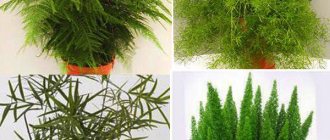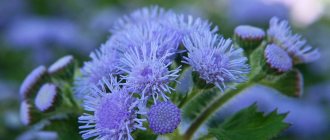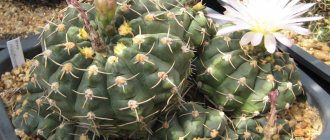The prickly pear cactus is one of the most interesting plants on the planet. This is the most common of the cactus genera. This largest succulent can go without water for months and grows in even the most nutrient-poor soils.
Prickly pear, like most cacti, is native to South America. It can grow in deserts and semi-deserts under the hot, scorching sun, as well as in the tropics and on the coasts of salty seas. Cacti are found all over the world. They are found in a wide variety of natural climate zones of other continents.
There are about 300 species. Cacti are unusual and unique in their shape and size. Different countries have their own representatives of these unusual plants, which farmers have adapted to their conditions and are happy to grow on their plots or plantations. Hobbyists grow them on windowsills or in greenhouses.
Prickly pear cactus description of species and varieties
The plant can reach a height of up to 4 meters. Within the prickly pear subfamily, there are different types of stems - globular, oval, cylindrical, discoid or articulated. Cacti can be vertical or creeping. The development of the root system does not occur inside the soil, but across its entire width.
The plant blooms beautifully, usually with large or medium-sized single flowers. These cacti are one of the few that have edible parts - fruits that form after the flowers wither. The fruits are sweet, fleshy and juicy; the pulp contains many flat seeds covered with a thick shell. Prickly pear fruits are covered with glochidia, small spines, just like the rest of the plant. Only the cactus itself has hard thorns.
Small glochidia are found in fascicles. They cause a lot of trouble to a person who carelessly touches the plant, driving their tiny spines into the skin.
Opuntia fig
Opuntia ficus-indica, the most famous succulent, is also known by other names such as prickly pear, Indian fig, Indian prickly pear, ficus indica, mother-in-law cactus (tongue). In nature, cacti are quite tall plants. “The fig cactus grows up to 4 meters in height and up to 2 meters in diameter. Prickly pear is not suitable for growing at home, but does well in a greenhouse.
The edible cactus blooms twice a year. Prickly Pear Flowers Are Multi-Colored – The flowers of the prickly pear are red, yellow or orange and are as colorful as its fruit. The fruits of the prickly pear are red, sweet and juicy. They are not only eaten raw, but also used for cooking.
Prickly pear is healthy and the fruit is nutritious and rich in vitamins and minerals. "Indian fig" is widely used in folk medicine and cosmetology.
Prickly pear
Opuntia microdasys - the native habitat of the cactus is central Mexico (Hidalgo state) in a mountainous area at an altitude of 1000 m above sea level. It is also found in North and South America and the Galapagos Islands.
This shrubby, branched plant is considered medium-sized, its height is about half a meter. The fleshy, flattened, green stems are completely covered with cuticles (axillary buds) that contain tiny, spiny, skin-like glochidia.
In the wild, this small hairy prickly pear blooms with beautiful lemon-yellow flowers 5-7 cm in diameter. In captivity, i.e. When grown at home, the plant rarely blooms. Therefore, the prickly pear likes to fruit in open habitat, producing red, oblong fruits.
Opuntia subulata
The genus Opuntia subulata, another name for the cactus "Austrocylindropuntia", has perhaps the most original form for a cactus. It's amazing how the cylindrical, thick stems of prickly pear look. They are covered with long white hairs. The stems have sharp, needle-like spines, as well as leaves, which the cactus sheds over time. Succulent stems stretch upward and grow strongly.
Opuntia subulata is a fast-growing plant, but at home it hardly blooms. In the wild, the flowers appear on the top of the stem and are yellow, orange, or bright red.
This species is often grown as a rhizome for other prickly pears. If grown as a house cactus, it will need a sunny place, but the prickly pear will grow even better and delight with its unusual appearance in a bright, airy greenhouse.
Prickly pear
Opuntia Vulgaris is native to the subtropical regions of South America. In its natural habitat, this type of cactus grows up to 5-6 m in height. She is considered the ancestor of all other prickly pears. The cactus grows quickly, forming bizarre bushes.
Opuntia has green, elongated, stem-like stems with few thorns, with thick, succulent segments growing from one another. The segments also form small leaves that fall off over time. The plant is equipped with sharp, numerous glochidia in the areoles. In the wild, the prickly pear blooms with beautiful yellow flowers, which is rarely seen at home. The prickly pear bears fruit from mid-summer to almost the end of summer. Bright burgundy-red, fleshy and juicy fruits reach 10 cm in size and weigh 100-300 grams.
Almost all parts of the plant are used in the household. The fruits and stems are food for people and domestic animals. The cactus is used for cosmetic and medicinal purposes. The flowers are used to make tea. The seeds are used to obtain healing oil. The plant is processed to produce glue and dyes.
Opuntia brazilian
Brasiliopuntia is a tree-like prickly pear. In the wild it can reach 20 meters in height. The favorite habitats of brasiliopuntia are near tropical rainforests. Therefore, those who want to grow this plant at home will have to take into account its size, as well as its love for moisture and regular watering.
Leaf-like, flat stems grow from the prickly trunk of the cactus. Fleshy dark green leaves are about 15 cm long. The needles, one and a half centimeters long, are evenly spaced and emerge from the cuticle. The cactus blooms with small (6 cm) yellow or beige flowers, which open alternately, as if prolonging the flowering time. At home, the cactus blooms very rarely.
The spherical or slightly oval fruits are small - 3-4 cm. The sweet-tasting fruits have a pleasant color, ripen yellow, red, orange and even purple with large hard seeds inside.
Garden prickly pear
Prickly pear is well suited for growing indoors, on a windowsill or outdoors in the garden. “The garden prickly pear is one of the few cacti that are not afraid of cold and snowy winters. The prickly pear, which proudly endures the cold in the open ground, will delight exotic lovers with its attractive, unusual appearance. And if we talk about landscape design, the garden prickly pear is a real find, creating colorful rockeries and lush flower beds. The buds appear in early summer, open in the sun, and the plant blooms.
Like any indoor and garden plant, it requires care: the right place for planting, watering, fertilizing and, possibly, winter warmth. But all efforts are rewarded, because the cactus brings joy and aesthetic satisfaction.
In addition, home cactus has medicinal properties and can be used as a diuretic and anti-inflammatory agent. It is good for headaches and hangovers. The juice contains substances that promote wound healing and antibacterial properties.
Opuntia monacantha
Opuntia Monacanta is a highly branched cactus with oval, flattened stems. The plant is covered with areoles with spines and glochidia. The cactus blooms with large yellow flowers 5-8 cm in diameter. Thanks to pollination, the prickly pear bears fruit, producing juicy, fleshy red fruits 5-6 cm long.
Growers love to grow Prunus monacanth at home because of its intricate bushy form and ease of cultivation.
Berger's prickly pear
Opuntia bergeriana is a common shrub cactus, quite tall - 4-5 m. Covered with thick, fleshy, elongated stems 40 cm long. Unlike others, this species of Opuntia blooms at a young age. During the flowering period, the plant is abundantly covered with bright red, medium-sized flowers. The stems of cacti are evenly dotted with halos of long sharp thorns.
At home, the height of the prickly pear is usually just over a meter, and the length of the stem leaves is about 25 cm. Proper care ensures abundant flowering and delights everyone with its beauty.
Care
Lighting
The cactus loves light very much, especially when there is a lot of it. The best option would be a window sill located in the south or southeast. It is also worth noting that it is better not to place the cactus directly under the sun so that it does not get burned. It should be gradually accustomed to the bright sun.
As for the winter period, additional lighting is not needed; the plant does well without it.
Watering
The plant should be watered with warm water, you can even boil it, but this is not necessary. In the warm season, the cactus should be watered frequently, not allowing the soil to dry out. Usually this is once a week, i.e. 4 times a month. However, if it is very hot outside and the soil dries out quite quickly, then the plant should be watered every 5-6 days.
In winter and during the dormant period, watering should be minimal. As a rule, once a month, maximum 2. The water is warm, 20-30 degrees, but its quantity should be 3-5 tablespoons.
In the summer, spraying from a spray bottle will also not be superfluous.
Temperature
As for temperature, Opuntia feels very good at a temperature of 25-35 degrees Celsius. If we talk about wintering, then at this time it is better to remove the cactus to a place where the temperature is 8-12 degrees. Also, temperature changes have a positive effect on development, since in natural conditions this happens quite often.
Air humidity does not matter; Opuntia tolerates both high and low humidity very well.
The soil
In most cases, the cactus grows very well in regular cactus soil, but this applies more to plants that are not yet five years old. For more mature cacti, it is recommended to use soil with a high content of sand and clay. Adding compost and a little ash will also be a plus. It is better not to use peat.
And don’t forget about crushed stone or crushed brick chips, which should be mixed with the ground.
Fertilizers
Feeding should be done during the period of active growth - usually spring. But you can apply fertilizers from the beginning of spring to the beginning of autumn. The best option would be fertilizers containing calcium, potassium and phosphorus, but there should be a minimum amount of nitrogen, as it negatively affects the development of the cactus, and sometimes even leads to the death of the plant. Feeding should be done once a week or 10 days, not more often.
But it is better to avoid fertilizing during the dormant period, since at this time it is better not to disturb the plant, and it can only cause harm.
Transfer
The replanting process is simple, and it must be done every 2-3 years, because during this time the soil wears out a lot and needs to be replaced, and the cactus will not grow in old soil.
Also read: Top 15 rare cacti. Unusual plants for the home!
For transplant you will need:
- Pot;
- Priming;
- Drainage (expanded clay, crushed stone, crushed brick).
In a new pot, a layer of drainage, 3-4 cm thick, is poured onto the bottom. Then, a layer of soil is poured on top. You can use ready-made soil if the plant is not yet 5 years old, or you can prepare the mixture yourself. To do this, in proportions 1:1:1:1:1:2, mix earth, sand, clay, crushed brick, ash and compost. Be sure to mix everything well.
So, now you should remove the cactus from the old pot. To do this, carefully turn the plant over and tap the bottom of the pot. Once you do this, shake off the old soil from the root system and check the roots themselves. Rotten ones should be removed, otherwise they can cause the development of diseases in the future. After this, place the cactus in a new pot and fill it with soil, but not completely - leave 1-2 cm.
That's basically it. After transplanting, you can water it with warm water.
Rest period
From the end of October to the end of February, Opuntia, like many other cacti, enters a dormant period. During this time, try not to touch or disturb the plant. Watering should be minimal, as described above. Under no circumstances should you turn, move or carry the plant, as during this period it is very sensitive and in case of the slightest stress, this will negatively affect flowering.
Bloom
If we talk about the flowering of the cactus itself, it occurs in the spring. Usually this time falls in May or even June, but this happens less frequently. The first flowers appear only in the third, and sometimes even in the fifth year, so don’t be too nervous if your “eared little one” hasn’t bloomed.
However, for some, even after this period, flowers do not appear, and then they begin to look for information on how to make the plant bloom. The answer is “No way.” The only way to make your pet bloom is to follow all the rules for caring for it. If the plant does not bloom, it means you are doing something wrong.
Prickly pear cactus medicinal properties
The prickly pear has a number of healing properties and is actively used in traditional and folk medicine in some countries. First of all, its hemostatic, diuretic, anti-inflammatory, and antibacterial properties are noted.
Due to its high concentration of glucose, protein, and chlorophyll, prickly pear is considered a natural antibiotic and absorbent that protects against harmful environmental influences.
Prickly pear for weight loss and digestion
Prickly pear is recommended for weight loss (the most commonly used is prickly pear). Crude dietary fiber is found in abundance in the plant.
Fiber increases stomach tension, which promotes a feeling of fullness. Cactus fruits suppress appetite. The synthesis of adipose tissue decreases. Fiber also removes sodium and excess water from the body. Stimulates intestinal motility. Improves metabolic processes in the body.
There are pharmacological forms of prickly pear, before using which you should definitely consult a doctor.
Strengthening the immune system
Prickly pear is rich in vitamin C, which is good for strengthening the immune system. This vitamin acts as an antioxidant, preventing the destruction of cellular structures. The beneficial properties of prickly pear increase the body's resistance to infectious diseases.
For teeth and bones
Prickly pear contains calcium, which is involved in bone formation. 99% of this element is deposited in the skeleton, nails and teeth. Cactus fruit is beneficial if you are at risk of developing osteoporosis, especially in older adults.
For the work of the heart
The medicinal properties of prickly pear improve the functioning of the cardiovascular system. They rid the body of “bad” cholesterol. In addition, consuming this plant reduces blood pressure. Strengthens the walls of blood vessels.
The medicinal properties of prickly pear include the prevention of atherosclerosis, stroke and coronary heart disease.
Cancer prevention
Organic compounds: flavonoids, polyphenols, betalains contained in cacti have an antioxidant effect on the body. They neutralize free radicals, preventing the development of cancer cells. Consequently, prickly pear fruits in the diet help prevent the development of cancer.
Improved sleep
The properties of the cactus help with stress or excessive excitability. The nutrients contained in the cactus increase the level of melatonin, which has a calming effect on insomnia. The plant normalizes blood pressure, which also promotes natural sleep.
For stomach ulcers
Mexicans have always treated this dangerous disease with cacti. Later, doctors recognized the effectiveness of cacti in treating stomach ulcers. Scientists even tested it on a group of volunteers in the acute phase of the disease. As a result, stable remission was achieved in all participants in the experiment.
The cactus contains a sticky substance and fibers, which, when consumed internally, improve the functioning of the stomach in cases of ulcers and gastritis.
For diabetes
Cactus has an antidiabetic effect on the body. It reduces cholesterol and bad lipids in the blood. With regular consumption of prickly pear, there is no sudden release of glucose into the body, and diabetic patients feel better.
Prickly pear cactus beneficial properties
The environment, stress, and overwork have a negative impact on the human body. The beneficial properties of prickly pear cactus are good protection against premature aging.
The usefulness of the cactus is due to its vitamin composition, micro- and macroelements. All parts of the cactus, its stems, fruits, flowers, which contain:
- dietary fiber - 3.7%,
- water - 87.5%,
- carbohydrates - 7.62%,
- protein - 0.72%,
- fats - 0.51%.
Vitamins: A, C, PP, B1, B2, B6, B9, beta-carotene. Micro-macroelements: potassium, magnesium, calcium, phosphorus, etc.
The beneficial acids contained in prickly pear are linoleic, oleic, stearic, palmitic, ascorbic, myristic and arachidic acids. All of them are actively used in cosmetology, pharmacology and the food industry.
For women
Opuntia vinegar from Tunisia is especially recommended for feminine beauty. Reduces swelling, eliminates cellulite. According to the manufacturer, the vinegar is 100% organic. Please read the instruction manual before purchasing.
For men
In the case of the prostate gland, urinary tract diseases are a serious problem for men, which brings pain and discomfort in their personal lives. The beneficial properties of prickly pear reduce inflammation. There are medications and nutritional supplements that stabilize organ function.
Modern cactus-based preparations, developed by scientists, help fight hangover syndrome by improving liver function and neutralizing the breakdown products of alcohol poisoning.
For athletes
There are many supplements containing cactus extracts. The beneficial properties of these supplements restore the body after long and grueling workouts. They saturate with vitamins, give strength, and relieve nervous tension caused by overwork.
For skin
The antioxidant properties of Opuntia, as well as the phytochemicals and acids it contains, have a rejuvenating effect on the skin. The use of cactus and skin cosmetics based on this plant gives the skin a healthy, fresh look and prevents the premature appearance of wrinkles and age spots.
Cuttings
Cuttings are considered the easiest way to propagate prickly pear . However, with prolonged and frequent propagation of the cactus by cuttings, the quality of the plant becomes lower and lower.
How to select and prepare cuttings?
When propagating by cuttings, it is important that the children cut for planting are fully mature. The segments can be used only after the cylindrical leaves growing from the areoles have completely fallen off.
- You need to cut the cuttings with a sterile blade, and sprinkle the cutting areas of both parts of the plant with crushed charcoal or sulfur powder.
- The cutting must be dried in a vertical position, placing it in a glass.
- When the cut site is healed, the shoot can be rooted.
Step-by-step instruction
After the place where the cutting is cut has dried , it can be rooted by performing the following steps:
- prepare disposable plastic cups with pre-made drainage holes in the bottom;
- fill the cups with soil mixture, as for an adult plant;
- Deepen the cuttings into the substrate by 2-3 cm.
The conditions for rooting a cutting are the same as for an adult plant, but without feeding. After 3-4 weeks, the first roots should appear.
Important! The cutting will be more viable if you cut it growing closer to the top of the cactus.
We invite you to watch a video about cuttings and rooting of prickly pears:
Eating
Prickly pear is used as a culinary ingredient in southern countries. In Mexico and Central America, for example, the national fava bean has been cooked for several decades. It is used in salads, used as a vegetable, eaten as a fruit, and a healthy, aromatic tea is made from its flowers.
In Spain, during the annual farmers' festival, you can try various dishes made from this cactus.
In some countries, after harvesting, cactus is used to make juice, sauces, pickle, bake or fry. It can also be used to make all kinds of desserts, sweetened or boiled in syrup. Opuntia fruits taste like juicy strawberries, raspberries or pears. You can make the most wonderful jams, creams, soufflés, canned food and other delicious dishes from cactus.
Prickly pear oil
To make this useful product, cactus flowers are used by decomposing them in vegetable oils. When combined, these substances combine with the fatty components, transferring all the beneficial properties of the flowers into the oil.
The oil is most often used in skin and hair care cosmetics.
The second way to obtain oil is by directly pressing the seeds of cactus fruits. The oil, enriched with vitamins, is popular in countries where the cactus grows. It is consumed by tourists bringing healthy exotics from Tunisia, Mexico and other countries.
Prickly pear extract
Cactus extract is used in pharmacology for the treatment and prevention of many diseases. In the cosmetics industry, cactus extract is also used for skin and hair care. It can be added to creams, lotions and other cosmetic products or used in its pure form.
There are recipes for preparing the extract yourself; the cactus is crushed and used fresh, as well as brewed or infused. And for best results, it is mixed with other beneficial ingredients such as honey, olive oil or alcoholic liquids.
Contraindications and harm
It is important to always remember that a beneficial plant should be used in moderation, as the cactus can cause harm.
- People prone to allergies should be careful with this exotic plant.
- Individual intolerance is possible.
- Pregnant women should postpone experimenting with cactus fruits and extracts containing cactus ingredients.
- People with chronic cystitis or hemorrhoids should avoid prickly pear and pear-based products.
Transfer
It is necessary to replant the cactus extremely rarely, since prickly pear takes a very long time to adapt to new conditions. Good reasons to replant a plant are:
- active growth in the first years of life;
- cramped pot;
- disease or pests;
- bush propagation.
A third of the substrate is poured into a new container from loose earth, humus and river sand with small pebbles. The cactus is transplanted there and covered with the remaining earthen mixture. After planting, the flower pot is placed in a dark room for two weeks.
Important! The substrate for transplantation must be dry.
Prickly pear at home
Gardeners strive to cultivate the exotic prickly pear cactus, providing it with care at home. They are planted in greenhouses or in the garden. Of course, getting beautiful flowers at home is not easy, but it is possible.
Follow all recommendations for caring for cactus plants.
- Make sure you have the right lighting and temperature in your home depending on the time of year.
- Watering also depends on the time of year and water quality. Most often, water is poured into trays; it is harmful for the plant if water gets on the leaves and stems.
- Periodic feeding is important for active plant growth. Cacti stop fertilizing during the flowering period.
- Like any other indoor plant, cacti need replanting, but they are painful to tolerate it. Transplantation is carried out after purchase and as it grows.
- Prickly pear can be grown at home from seeds. After the seedlings grow up, they are transplanted into containers, with plans to later transplant them into larger pots.
The prickly pear cactus is a strong plant and rarely gets sick, but it can also have problems if it is not cared for properly. There are always methods to combat dangerous pests, the main thing is to recognize the disease in time.
In order for the exotic prickly pear to bloom and possibly bear fruit, you must try to create a comfortable microclimate and favorable conditions for the plant.
Reproduction
Sowing seeds
Prickly pear seeds have a hard shell. Before sowing (in mid-March), their surface is treated with a file or sandpaper, and then soaked for 30 minutes in a weak solution of potassium permanganate.
Then the seeds are planted in a container with moist soil and covered with glass. Shoots appear at a temperature of 20°C. Grown cacti are planted in individual pots after 3 months, and after 2 years they are transplanted. Flowering occurs 3–5 years after planting.
Cuttings
For planting, select a healthy stem segment from above without buds and flowers. Cut it off with a sharp knife. The ends of the cut are shaped into a cone so that the roots emerge from the center.
The cuttings are dried for several days until a crust forms on the cut. Then placed in a damp mixture of sand and peat.
Rooting is faster in humid and warm conditions. The shoot is covered with a glass jar, rarely watered, but ventilated. Replant after roots appear.











